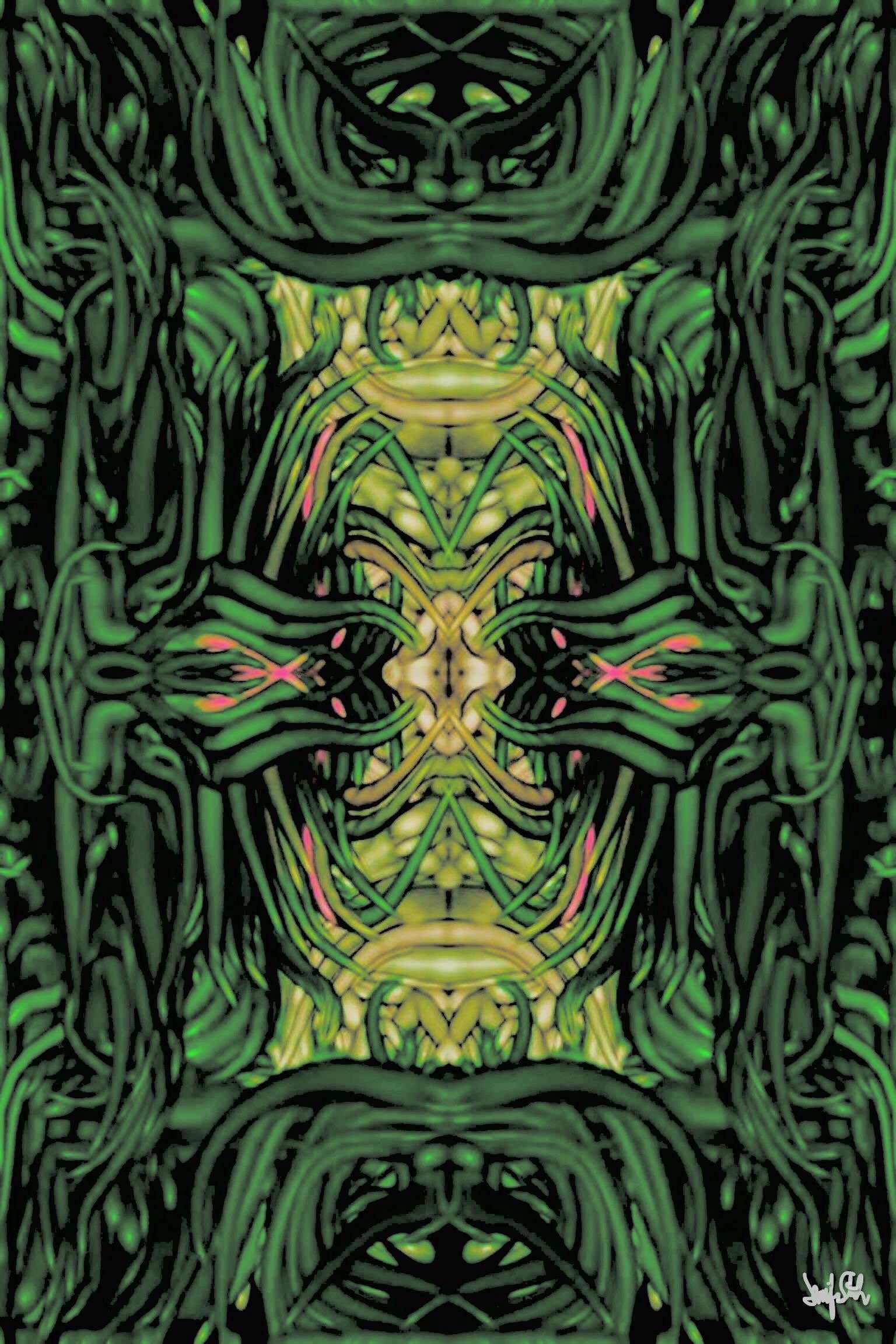 Image 1 of 1
Image 1 of 1


Throne of the Verdant Oracle The Rootkeeper
This symmetrical, richly organic composition evokes the feeling of standing before a sacred presence—part guardian, part throne, part breathing jungle. The forms are dense, interwoven, and muscular, composed of vine-like structures, ribbed limbs, and leaf-veined armor. The central figure suggests an enthroned deity or nature-bound sentinel, eyes hidden, yet omniscient, with an air of quiet, ancient authority.
Dominated by deep forest greens and muted chartreuse, with subtle accents of petal-pink and earth-gold that hint at blossoms or inner illumination. The dark background intensifies the glow of the biomorphic forms. The bilateral symmetry creates a totemic structure, calling to mind both cathedral architecture and insectoid exoskeletons. The repeated X and V forms at the center suggest intersection, containment, and balance. The image has a visceral, almost tactile presence, like carved jade, wet bark, or twisting musculature. It pulses with quiet tension—alive, coiled, waiting.
This piece could serve as the anchor of a visionary journey, representing the Guardian of Thresholds or the Green Oracle—a keeper of ancient truths, encoded in nature’s geometry and the spiral of plant growth. Ideal as a central or climax piece in your series, it could embody the moment when the seeker meets their counterpart in the spirit realm—a silent transmission of knowing through form, color, and pattern.
This artwork conjures the image of a sentient, vegetal entity—an ancient guardian woven from vines, roots, and verdant breath. Lush greens dominate the symmetrical structure, with faint blushes of pink and golden light hinting at vitality and hidden blooms. At the center, interlocked hands or tendrils appear to cradle a seed or heart, suggesting nurturing, preservation, or the protective force of nature’s intelligence.
The black negative space outlines the figure like a temple portal, enhancing the sense that the viewer is peering into a sacred forest shrine or the inner sanctum of an Earth spirit. “The Rootkeeper” embodies grounded wisdom, stillness, and the interconnected web of life. It might be an archetype of the subconscious that tends growth in shadow, protecting latent potential and ancient knowledge buried deep within.
This symmetrical, richly organic composition evokes the feeling of standing before a sacred presence—part guardian, part throne, part breathing jungle. The forms are dense, interwoven, and muscular, composed of vine-like structures, ribbed limbs, and leaf-veined armor. The central figure suggests an enthroned deity or nature-bound sentinel, eyes hidden, yet omniscient, with an air of quiet, ancient authority.
Dominated by deep forest greens and muted chartreuse, with subtle accents of petal-pink and earth-gold that hint at blossoms or inner illumination. The dark background intensifies the glow of the biomorphic forms. The bilateral symmetry creates a totemic structure, calling to mind both cathedral architecture and insectoid exoskeletons. The repeated X and V forms at the center suggest intersection, containment, and balance. The image has a visceral, almost tactile presence, like carved jade, wet bark, or twisting musculature. It pulses with quiet tension—alive, coiled, waiting.
This piece could serve as the anchor of a visionary journey, representing the Guardian of Thresholds or the Green Oracle—a keeper of ancient truths, encoded in nature’s geometry and the spiral of plant growth. Ideal as a central or climax piece in your series, it could embody the moment when the seeker meets their counterpart in the spirit realm—a silent transmission of knowing through form, color, and pattern.
This artwork conjures the image of a sentient, vegetal entity—an ancient guardian woven from vines, roots, and verdant breath. Lush greens dominate the symmetrical structure, with faint blushes of pink and golden light hinting at vitality and hidden blooms. At the center, interlocked hands or tendrils appear to cradle a seed or heart, suggesting nurturing, preservation, or the protective force of nature’s intelligence.
The black negative space outlines the figure like a temple portal, enhancing the sense that the viewer is peering into a sacred forest shrine or the inner sanctum of an Earth spirit. “The Rootkeeper” embodies grounded wisdom, stillness, and the interconnected web of life. It might be an archetype of the subconscious that tends growth in shadow, protecting latent potential and ancient knowledge buried deep within.